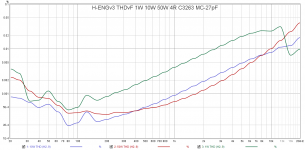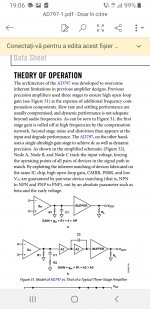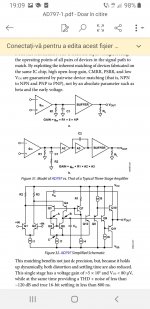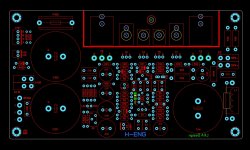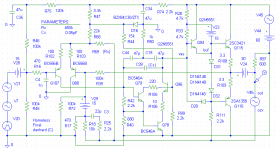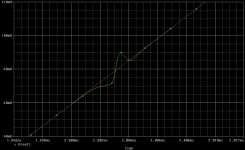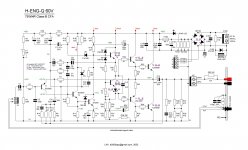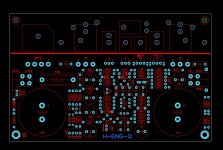I'm sure that's true.guys, applying three-pole compensation to any amp is not straightforward (and get better performance than 2P) . try and you'll see.
I'm betting that having essentially unity gain between the compensation network and the output minimizes the tendency toward "sticking" when the amp is driven into mild overload.
Again, my compliments on very fine work!
"To have a 3rd pole or not ... that is the question" .Just found one of the forgotten discussions that makes me regret SW as if he was dead...
https://www.diyaudio.com/community/threads/class-a-biasing-for-the-ad797.123613/
and the reevaluation:
https://www.diyaudio.com/community/...erential-or-single-ended-phono-preamp.306811/
Just rambling here...was just looking over Teac AS 100 schematic because i have a friend who bought and sold over 30 amplifiers over the last 10 years and could never part with its first amp which happened to be Teac AS 100...Some retro amps are just impossible to betray.Class B revival might just be the last of the mohicans's revenant so why not?!
https://www.diyaudio.com/community/threads/class-a-biasing-for-the-ad797.123613/
and the reevaluation:
https://www.diyaudio.com/community/...erential-or-single-ended-phono-preamp.306811/
Just rambling here...was just looking over Teac AS 100 schematic because i have a friend who bought and sold over 30 amplifiers over the last 10 years and could never part with its first amp which happened to be Teac AS 100...Some retro amps are just impossible to betray.Class B revival might just be the last of the mohicans's revenant so why not?!
Attachments
I am certain you are right, but I am equally sure that it is doable (with some efforts, obviously).guys, applying three-pole compensation to any amp is not straightforward (and get better performance than 2P) . try and you'll see.
That said, I am not married to the conventional topology: if a solution works, it is OK, let's get rid of preconceptions and ideas about what's "right" or "wrong".
You are in good company anyway, since Renardson is also a fan of single-supply amplifiers, and he also made some notable achievements.
I have also proposed a number of single-supply projects, and I have made a single supply version of the circlophone
Looks great. Looking forward to the finished piece. A few quick questions:preview of the new 60V-75V powered PCB
- Is there any advantage to class AB operation, as you mentioned in post #15, and will you be including the option of emitter resistors?
- What is the gain of the amplifier, and is it adjustable (easily, via a resistor). Asking because I have been experimenting with different preamps, and this would make a great power module; although I realize it is self-sufficient.
Actually the cause of lower thd at higher outputs is the effect of the bootstrap.Remove the bootstrap and you can see lower distortions at lower outputs again, but much higher thd at high output.I'm feeling a bit mean here, but I'm noticing a rising distortion characteristic at higher frequencies for the 1W/3mA plot - more so than for the higher-power traces.
If this is indicative of crossover distortion, then a plot for 100mW could be very revealing.
As I say, I feel a bit mean because I think the work you've done here is really useful.
Looks great. Looking forward to the finished piece. A few quick questions:
- Is there any advantage to class AB operation, as you mentioned in post #15, and will you be including the option of emitter resistors?
- What is the gain of the amplifier, and is it adjustable (easily, via a resistor). Asking because I have been experimenting with different preamps, and this would make a great power module; although I realize it is self-sufficient.
1. I didn't see a measurable difference.
2. The gain is 21 (26.5dB) and can be slightly modified.
By the way, within a moth I want to try a quasi-complementary version (the pcb will accommodate to3p/to247/to3)
Three stage and three pole is different. Three stage is 3x gain stage. Three pole is 3x pole in the compensation. What is your point?"To have a 3rd pole or not ... that is the question" .Just found one of the forgotten discussions that makes me regret SW as if he was dead...
https://www.diyaudio.com/community/threads/class-a-biasing-for-the-ad797.123613/
and the reevaluation:
https://www.diyaudio.com/community/...erential-or-single-ended-phono-preamp.306811/
Here you have a class B amplifier and negative impedance can't be fought with just added independent emitter resistors as it would interfere with the class B itself while the feedback needs to get that class B output pair operate in the linear region when it's needed, so you can only add general output inductances to fight the negative impedance although you can hardly get negative impedance with class B output as there's no gm doubling.The output inductance in class b amps is only trying to separate the feedback action from the speaker's impedance game to make the class B stage operate in a purely current dumping fashion if possible.The reliability of version with Re emitter resistors would be definitely better than without them. Especially under unexpectedly difficult conditions with complex load.
https://www.google.com/url?sa=t&sou...8QFnoECA8QBg&usg=AOvVaw2tNdYPg4zsrAOrGkcFMGnE
Last edited:
Simulation is a toy and is addictive 
It's a dc simulation, the capacitors replaced by a voltage source.
No symmetry, no current sources and current mirrors, all topologies are 50 years old, distortion -140dBc
At minimum distortion there is a trimmer, it will please
It's a dc simulation, the capacitors replaced by a voltage source.
No symmetry, no current sources and current mirrors, all topologies are 50 years old, distortion -140dBc
At minimum distortion there is a trimmer, it will please
Attachments
Last edited:
Have you tried TMC with either one or both capacitors replaced by a TPC arrangement. Can get crazy loop gains around the output stage this way.
The nice square wave response of TMC can be preserved if you replace only the capacitor that is usually driven by the VAS with a TPC network.
The nice square wave response of TMC can be preserved if you replace only the capacitor that is usually driven by the VAS with a TPC network.
- Home
- Amplifiers
- Solid State
- Single supply, three-pole compensated class-B retro amp
